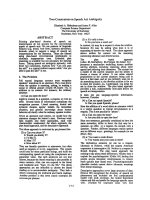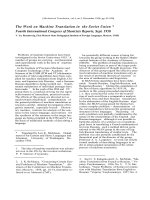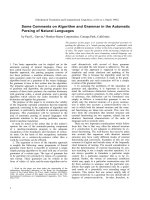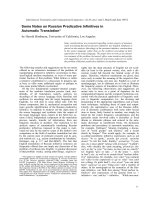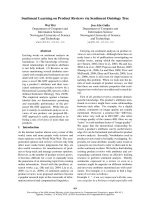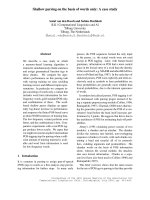Báo cáo khoa học: "Physical damage on tropical tree saplings: quantification and consequences for competition through height growth in a neotropical rain forest of French Guiana" pdf
Bạn đang xem bản rút gọn của tài liệu. Xem và tải ngay bản đầy đủ của tài liệu tại đây (840 KB, 16 trang )
Original
article
Physical
damage
on
tropical
tree
saplings:
quantification
and
consequences
for
competition
through
height
growth
in
a
neotropical
rain
forest
of
French
Guiana
Gilles
Koestel
a
Judy
M.
Rankin-de
Mérona
b
Station
de
recherches
forestières,
Inra,
Centre
Régional
de
Guyane,
BP
709,
97387
Kourou
cedex,
France
(Received
29
July
1996;
revised
2
April
1997;
accepted
25
May
1998)
Abstract -
This
paper
deals
with
the
quantification
and
the
effects
of
physical
damage
on
tree
regeneration
dynamics
in
the
tropical
rain
forest.
We
define
physical
damage
as
breakage
resul-
ting
in
a
greater
than
20
%
reduction
in
stem
diameter
and
its
associated
effects.
A
study
of
phy-
sical
damage
at
the
community
level
was
made
in
March
1994
in
primary
forest
and
forest
distur-
bed
by
silvicultural
treatments
at
the
Paracou
research
site
in
French
Guiana.
The
frequency
of
damage
varies
with
diameter
class
and
the
degree
of
forest
disturbance
due
to
the
silvicultural
treatments,
ranging
from
14.9
%
for
saplings
greater
than
6
cm
DBH
in
undisturbed
forest
to
over
50
%
for
smaller
saplings
in
disturbed
forest.
Study
at
the
specific
level
was
made
at
the
same
site
on
saplings
of
three
tree
species
with
contrasting
ecological
temperaments,
Bocoa
prouacen-
sis,
Pradosia
cochlearia
and
Goupia
glabra,
from
March
1994
to
March
1996.
Damage
frequen-
cies
varied
from
34
%
for
saplings
of
the
pioneer
species
Goupia
glabra
to
64
and
60
%,
respecti-
vely,
for the
more
shade
tolerant
species
Bocoa
prouacensis
and
Pradosia
cochlearia.
Physical
damage
does
not
directly
influence
height
or
diameter
growth
rates
nor
mortality
within
a
species
except
for
Pradosia
cochlearia.
However,
diameter
growth
rates
irrespective
of
damage
are
significantly
different
between
species.
Under
certain
circumstances,
stem
breakage
may
be
an
influential
factor
affecting
the
long
term
survival
of
pioneer
species
saplings
because
it
modifies
their
social
status.
(©
Inra/Elsevier,
Paris.)
growth
/
saplings
/
competition
/
mortality
/
stem
breakage
/
tropical
rain
forest
Résumé -
Casse
mécanique
sur
des
jeunes
arbres
tropicaux :
quantification
et
consé-
quences
sur
la
compétition
par
la
croissance
en
hauteur
dans
une
forêt
néotropicale
humide
de
Guyane
française.
Ce
travail
portant
sur
la
quantification
et
les
effets
de
la
casse
mécanique
sur
la
dynamique
de
la
régénération
des
arbres
en
forêt
dense
humide
tropicale,
a
été
envisagé
à
*Correspondence
and
reprints
E-mail:
deux
niveaux
de
perception
sur
le
dispositif
de
recherche
de
Paracou,
en
Guyane
française.
Une
étude
au
niveau
peuplement
sans
prise
en
compte
des
espèces
a
été
réalisée
en
mars
1994
en
forêt
primaire
et
en
forêt
perturbée
par
des
traitements
sylvicoles.
Le
pourcentage
de
casse
varie
selon
les
classes
de
diamètre
et
l’importance
de
la
perturbation
due
aux
traitements,
depuis
14,9
%
pour
les
jeunes
arbres
de
DBH
supérieur
à
6
cm
en
forêt
naturelle,
à
plus
de
50
%
pour
ceux
de
petits
diamètres
dans
des
sites
perturbées.
L’étude
au
niveau
spécifique
a
été
réalisée
sur
trois
espèces
aux
tempéraments
écologiques
contrastés,
Bocoa
prouacensis,
Pradosia
cochlearia
et
Goupia
glabra,
entre
mars
1994
et
mars
1996.
Les
jeunes
arbres
de
l’espèce
pionnière
Goupia
glabra
sont
moins
fréquemment
endommagées
(34
%)
que
celles
des
espèces
plus
tolérantes
d’ombre,
Bocoa
prouacensis
(64
%)
et
Pradosia
cochlearia
(60
%).
La
casse
mécanique
n’influence
pas
directement
les
taux
de
croissance
des
tiges
en
hauteur
ou
en
diamètre
pour
une
espèce,
sauf
pour
Pradosia
cochlearia.
Cependant,
la
croissance
en
diamètre,
sans
prendre
en
compte
des
dégâts
mécaniques,
est
significativement
dif-
férentes
entre
espèces.
La
casse
mécanique,
dans
certaines
circonstances,
peut
avoir
une
influence
importante
sur
la
survie
à
long
terme
des
jeunes
arbres
d’espèces
pionnières,
car
elle
modifie
leur
statut
social.
(©
Inra/Elsevier,
Paris.)
croissance
/
jeune
arbre
/
compétition
/
mortalité
/
casse
mécanique
/
forêt
tro-
picale
humide
/
1.
INTRODUCTION
Studies
on
population
dynamics
and
tree
regeneration
in
tropical
rain
forests
have
shown
the
importance
of
physical
damage
on
seedling
and
sapling
mortality
[1,
7-9,
14,
29,
30].
Physical
damage
is
the
mechanical
breakage
of
a
stem
by
an
animal
(due
to
tramping,
scraping,
push-
ing,
biting
or
boring
for
example)
or
by
material
falling
from
a
higher
stratum
of
the
vegetation.
Whereas
seedlings
are
more
likely
to
be
completely
crushed,
saplings
most
frequently
suffer
from
breakage
or
stem
deformations
resulting
in
significant
modification
of
future
growth.
This
damage
may
either
lead
to
increased
mortality
or,
in
the
case
of
sur-
vival,
to
changes
in
growth
trajectories.
We
can
surmise
that
individuals
reaching
the
young
tree
stage
and
emerging
from
the
understory
may
already
have
a
long
and
eventful
past
history.
If
we
take
into
account
the
notion
of
species
in
the
study
of
physical
damage
on
saplings,
we
can
evaluate
how
it
influ-
ences
mortality,
growth
and
competition
dynamics.
This
approach
is
interesting
in
light
of
the
nuances
revealed
by
some
studies
contrasting
the
differences
between
pioneer
species
and
shade
toler-
ant
ones
[1, 9].
We
ask
the
following
questions.
1)
In
what
way
does
the
ecological
temperment
of
a
species
influence
the
frequency
of
damage
to
saplings?
2)
For
a
given
individual
of
a
given
species,
is
physical
damage
automatically
detrimental
in
comparison
to
another
individual
of
the
same
species
with
no
breakage,
especially
under
conditions
of
active
competition?
3)
In
which
terms
does
physical
dam-
age
affect
sapling
growth,
in
height
or
diameter,
and
in
what
proportion?
Is
there
a
direct
or
indirect
consequence
of
stem
breakage
on
these
parameters?
We
undertook
a
study
of
the
effects
of
damage
by
breakage
on
the
growth
and
survival
of
saplings
of
three
tropical
rain
forest
tree
species
in
native
and
silvicul-
turally
treated
forest
in
order
to
answer
these
questions.
2.
MATERIALS
AND
METHODS
2.1. Study
site
This
study
was
carried
out
at
the
Paracou
Tropical
Forest
Research
Site
of
Silvolab,
a
co-ordination
unit
set
up
by
French
research
institutes
(current
members
are
CIRAD-Forêt,
Inra,
ENGREF,
ORSTOM,
ONF
and
MNHN)
for
forest
ecosystem
studies
in
French
Guiana.
Located
in
the
dense
upland
rain forest
of
north-eastern
South
America
(2-6°
N,
51°30’53°30W)
(figure
1),
the
climate
is
con-
sidered
as
equatorial,
characterised
by
peren-
nial
high
(80-90
%)
humidity,
low
tempera-
ture
variation
centred
around
26 °C
and
a
rarity
of
violent
winds
[15].
Mean
annual
rain
fall
for
the
last
10
years
is
4
976
+/-
SD
243
mm
(CIRAD-Forêt
à Kourou,
unpub-
lished
data).
Rainfall
distribution
is
unequal
over
the
year
(figure
2).
The
main
dry
season
occurs
between
August
and
November,
with
another
short
dry
season
during
March
or
April.
Average
annual
temperature
is
26 °C.
The
forest
structure
and
composition
are
generally
similar
to
other
upland
rain
forest
sites
in
South
America,
all
the
while
possess-
ing
a
Guianian
character
by
virtue
of
a
small
number
of
relatively
abundant
tree
species
in
a
nonetheless
species-rich
forest.
The
three
most
representative
families
of
trees
attaining
at
least
10
cm
in
diameter
at
breast
height
(DBH)
in
the
Paracou
forest
are
the
Lecythidaceae
(18
%
of
the
individuals),
the
Caesalpinaceae
(13
%)
and
the
Chrysobalanaceae
(12
%)
[11].
The
principal
tree
species
are
the
Eschweilera
spp.
(Lecythidaceae),
the
Licania
spp.
(Chryso-
balanaceae),
Eperua
falcata,
mouamba,
Bocoa
prouacensis
(this
study),
bouchi
mango,
Iryanthera
spp.,
bakouman,
Eperua
grandiflora,
Symphonia
globulifera,
moni,
Vouacapoua
americana,
Pradosia
cochlearia
(this
study),
Qualea
rosea
Carapa
procera,
patawa,
and
Dicorynia
guianensis
[24].
From
a
structural
point
of
view
there
are
on
the
average
618
stems/ha,
with
a
mean
basal
area
of
31
m2
/ha
[10].
Approximately
60
%
of
the
stems
are
20
cm
in
DBH
or
less
[24].
While
emergents
may
reach
45
m
in
height,
the
gen-
eral
level
of
the
canopy
is
around
40
m
(B.
Ferry,
pers.
com.).
The
experimental
site
is
composed
of
12
plots
of
9
ha
(each
surrounded
by
a
25
m
wide
buffer
zone)
distributed
over
three
replicated
blocks
consisting
of
four
silvicultural
treat-
ments,
including
a
control
[27].
The
treat-
ments,
applied
once
in
October
1986
to
May
1987
for
logging
and
December
1987
to
January
1988
for
poison
girdling,
are:
-
treatment
0:
control
(mean
basal
area
(ba)
=
32
m2
/ha);
-
treatment
1:
selective
logging
above
50
cm
DBH
(mean
remaining
ba
after
logging
=
24
m2
/ha;
-
treatment
2:
selective
logging
plus
thin-
ning
by
poison
girdling
(ba
after
logging
=
19
m2
/ha);
-
treatment
3:
selective
logging
plus
thin-
ning
by
poison
girdling
and
fuel
wood
extrac-
tion
(ba
after
logging
=
16
m2
/ha).
2.2.
Methods
Frequency
of
breakage,
survival,
height
and
diameter
growth
rates
for
damaged
and
undamaged
stems
were
analysed
at
both
the
community
level
and
the
specific
level.
At
the
community
level,
the
frequency
of
breakage
on
saplings
regardless
of
species
was
estimated
on
randomly
oriented
transects
20
m
long
and
2
m
wide,
with
origins
located
every
40
m
on
a
square
grid.
A
total
of
96
transects
were
censused
on
three
parcels
(con-
trol,
first
level
and
second
level
treatments;
with
32
transects
per
parcel).
Measurements
were
made
on
individuals
of
more
than
1.5
m
in
height
and
less
than
10
cm
DBH.
Diameter
was
measured
by
classes
of
1
cm
intervals
with
a
notched
gauge
(figure
3).
Frequencies
of
damage
were
assessed
using
Clark
and
Clarks
method
based
on
comparison
of
main
stem
diameters
above
and
below
breakage
points
as
indicated
by
major
discontinuity
or
scarring
[9].
From
this
a
discontinuity
ratio
can
be
established
as:
discontinuity
ratio
=
100
*
(diameter
above
scar/diameter
below
scar).
Clark
and
Clark
[9]
fixed
the
lower
limit
of
discontinuity
at
25
%.
This
means
that
a
stem
with
a
discontinuity
less
than
25
%
was
con-
sidered
as
undamaged.
But,
as
they
recognise
themselves,
this
criterion
is
quite
conserva-
tive,
leading
to
under-estimates.
After
a
pre-
liminary
investigation
of
different
critical lev-
els
for
breakage
acceptance
(10,
15,
20
and
25
%),
we
decided
to
lower
the
level
of
accep-
tance
to
20
%.
However,
results
at
the
com-
munity
level
were
not
different
for
the
two
limits.
Measures
above
and
below
the
scar
were
made
with
a
caliper
every
time
disconti-
nuity
was
doubtful.
It
is
difficult
to
distinguish
vertebrate
damage
from
limbfall
or
treefall
effects
and
we
assume
that
the
greatest
contri-
butions
to
any
observed
species
differences
depends
on
the
species
themselves
and
not
the
cause
of
the
damage.
The
species
level
effects
of
damage
were
studied
for
three
tree
species
of
contrasting
ecological
temperaments.
The
individuals
studied
were
tagged
saplings
located
on
circu-
lar
plots
(radius
3.72
m)
located
throughout
the
12
plots
of
9
ha
mentioned
above,
and
forming
part
of
the
Inra
(Institut
national
de
la
recherche
agronomique)
natural
tree
regenera-
tion
study
(see
[27]
for
the
site
description
and
[26]
for
details
of
the
inventory
protocol
and
data
base).
The
positions
of
the
plots
corre-
spond
to
the
origins
of
the
community
level
transects
on
the
40
by
40
m
square
grid,
thus
the
observations
at
these
two
levels
were
con-
ducted
in
the
same
zones.
All
the
saplings
(n
=
80
for
each
species)
were
more
than
1.5
m
in
height
and
less
than
5
cm
DBH,
the
upper
limit
being
determined
by
the
difficul-
ties
in
accurately
measuring
heights
of
more
than
7
m,
the
maximum
length
of
our
cali-
brated
telescopic
pole.
Height
measurements
were
thus
made
to
the
centimetre
for
heights
up
to
7
m.
Measurements
of
DBH
for
all
the
saplings
and
the
diameter
above
and
below
scar
for
damaged
saplings
considered
as
dam-
aged
were
made
twice
with
a
millimetric
caliper,
each
diameter
being
the
mean
of
two
perpendicular
diameters.
All
measurements
were
made
once
in
March
1994
and
were
repeated
in
March
1966
in
order
to
evaluate
the
diameter
and
height
growth.
2.3.
Species
studied
Bocoa
prouacensis
Aubl.
(Caesalpi-
niaceae)
is
a
relatively
common
mid-canopy
tree
species
which
attains
30
m
in
height
and
is
shade
tolerant
as
an
adult
[4,
11].
Seed
dis-
persal is
endozoochorous
(spider
monkeys)
and
synzoochorous
(bats,
such
as
Artiibeus)
[31].
Pradosia
cochlearia
(Lecomte)
Pennington
(Sapotaceae)
is
an
emergent
tree
with
an
adult
height
of
about
40-45
m.
Its
large
typically
sapotaceous
berries
are
dispersed
by
monkeys
[31].
Like
Boco,
the
saplings
of
Kimboto
are
relatively
shade
tolerant
[19]
yet
growth
can
be
stimulated
by
increased
light
following
for-
est
canopy
opening
[25].
Goupia
glabra
Aubl.
(Celastraceae)
is
a
long-lived
pioneer
tree
species
[6]
with
very
small
fruits
of
about
1
cm
and
few
seeds
[2,
3,
13]
present
throughout
the
rain
forest
soil
seed
bank
[21].
It
is
a
light-demanding
species
from
germination
until
death
and
grows
rapidly
[18].
It
quickly
colonises
gaps
and
open
sites
[6],
especially
on
disturbed
soils
[28]
such
as
logging
trails.
For
these
reasons,
Goupia
glabra
usually
appears
on
favourable
sites
in
dense
groups
of
relatively
numerous
individuals
among
other
pioneer
species
[17].
Mature
trees
are
emergent,
with
a
maximum
height
surpassing
40
m
[12,
20]
and
a
lifespan
of
more
than
100
years.
Bocoa
prouacensis,
Pradosia
cochlearia
and
Goupia
glabra
are
among
the
14
more
common
species
(for
all
diameter
classes)
at
Paracou
in
the
control
parcels
[3,
10].
The
number
of
Goupia
glabra
saplings
increased
steadily
on
treated
parcels
after
logging
and
silvicultural
interventions
[3,
19]
while
Bocoa
prouaceusis
remained
unchanged
or
decreased
[19, 25].
3.
RESULTS
3.1.
Frequency
of
damage
in
1994
The
overall
frequency
of
damage
observed
on
the
transects,
all
species
con-
sidered,
is
40.6
%
(n
=
3
681).
Damage
frequency
is
essentially
equal
for
the
con-
trol
and
treatment
level
1
(41.9
and
41.5
%
for
n
=
968
and
1 421,
respec-
tively)
and
only
slightly
less
for
treatment
level
2
(38.5
%,
n
=
1
292).
For
saplings ≤
4
cm
DBH,
damage
fre-
quency
is
43.9
%
(n
=
852)
on
control
plots
in
our
study
(table
I)
as
compared
to
19.5
%
(n
=
794)
in
Clark
and
Clark’s
study
[9]
limited
to
nine
canopy
tree
species
at
the
La
Selva
Biological
Station,
Costa
Rica.
The
difference
for
saplings >
4-10
cm
DBH
on
control
plots
is
somewhat
less,
with
a
damage
rate
of
27.6
%
(n
=
116)
in
our
study
compared
to
22.8
%
(n
=
281)
in
Clark
and
Clark’s
study
[9].
These
figures
remain
virtually
identical
whether
using
our
20
%
discon-
tinuity
threshold
or
theirs
at
25
%.
As
already
mentioned
by
these
authors,
frequency
of
damage
and
diame-
ter
class
are
not
independent.
At
Paracou,
we
find
that
the
ratio
of
broken
to
intact
stems
varies
by
more
than
chance
among
the
four
diameter
classes
under
all
condi-
tions
(table
I:
for
df
=
3,
in
the
control,
chi-square
= 16.5,
P
<
0.001;
in
level
1,
chi-square
= 14.7,
P
=
0.01;
in
level
2,
chi-square
= 24.7,
P
=
0.001).
In
the
control
plots
there
is
a
greater
occur-
rence
of
damage
in
the
two
lower
size
classes
while
damage
is
greatest
for
the
intermediate
sizes
in
the
treatment
plots
(table
I).
For
saplings
<
2
cm
DBH,
the
frequency
of
damage
is
significantly
higher
in
the
control
over
the
treated
plots
(df
=
2,
chi-square
=
12.3,
P
<
0.001).
The
least
damage
(14.9
%)
is
encountered
for
the
largest
saplings >
6-10
cm
DBH
in
undisturbed
forest.
However,
no
signif-
icant
differences
exist
between
this
and
the
frequencies
observed
in
the
first
and
second
treatment
levels for
this
size
class
(df
=
2;
chi-square
=
5.8;
P
>
0.05),
nor
for
any
of
the
other
size classes.
We
also
examined
the
initial
overall
frequency
of
stem
damage
for the
three
species
chosen
for
the
growth
and
sur-
vivorship
studies.
Differences
in
fre-
quency
of
damage
among
species
are
highly
significant
(df
=
2,
chi-
square
=
17.3;
P
<
0.001)
because
fre-
quency
of
damage
is
very
high
for
Bocoa
prouacensis
(64
%;
n
=
72)
and
Pradosia
cochlearia
(59.5
%;
n
=
78)
and
nearly
double
that
observed
for
Goupia
glabra
(34
%;
n
=
85).
3.2.
Two
year
mortality
rates
Mortality
between
1994
and
1996
due
to
physical
damage
varied
widely
between
the
three
species
studied.
Mortality
was
high
for
Goupia
glabra
(21
of
85
individuals)
but
less
than
half
of
this
is
apparently
due
to
physical
damage:
nine
saplings
broken
among
the
21
which
died
over
the
period.
Six of
the
seven
Pradosia
cochlearia
that
died
(of
78
ini-
tially)
had
their
stems
broken.
Only
one
Bocoa
prouacensis
of
72
tagged
stems
died
and
that
individual
had
its
stem
bro-
ken
in
1994,
and
thus
does
not
figure
in
the
following
analysis.
The
comparison
of
heights
and
diame-
ters
in
1994
between
stems
dying
during
the
subsequent
2
year
period
and
those
surviving
(table
II)
shows
certain
signifi-
cant
differences
by
species,
with
those
dying
have
smaller
initial
heights
and
diameters
(for
initial
diameters:
median
1-way
analysis
chi-square
=
7.228;
df
=
1;
P
<
0.01
for
Goupia
glabra;
anal-
ysis
chi-square
=
5.745;
df
=
1;
P
<
0.05
for
Pradosia
cochlearia;
for
initial
height:
median
1-way
analysis
chi-
square
=
4.789;
df
=
1;
P
<
0.05
for
Goupia
glabra;
analysis
chi-
square
=
3.873;
df
=
1;
P
<
0.05
for
Pradosia
cochlearia).
The
median
value
was
used
in
this
comparison,
being
more
representative
of
location
due
to
distribu-
tion
skewness.
3.3.
Rates
of
growth
in
height
and
diameter
Growth
rate
between
March
of
1994
and
March
1996
were
measured
for
the
saplings
that
did
not
die,
suffer
disease
and/or
physical
damage
during
the
period,
as
far
as
we
were
able
to
discern.
For
this
reason,
the
sample
size
for
this
part
of
the
study
was
reduced
as
com-
pared
to
the
initial
sample
of
tagged
seedlings.
True
values
of
mean
diameter
growth
are
difficult
to
establish
due
to
difficulty
in
accurately
repeating
mea-
surements
on
an
irregular
stem
where
the
site
of
measurement
can
not
be
perma-
nently
marked
without
risk
of
damage
to
the
plant,
and
due
to
the
great
difference
in
overall
diameter
and
actual
diameter
growth
over
the
observation
period
(table
III).
Moreover,
regarding
stem
shrinkage
[16],
for
a
short
observation
period
such
as
2
years,
true
gains
may
be
masked
if
the
second
measure
is
made
when
the
stem
is
significantly
less
hydrated
or
under
greater
hydric
stress
than
at
the
first
measure.
In
this
study,
this
problem
was
minimised
by
taking
the
measure-
ments
during
the
same
seasonal
period.
Nevertheless,
we
can
observe
highly
significant
differences
among
species
(table
III)
in
diameter
growth
rates
(Kruskall-Wallis
test;
df
=
2;
chi-
square
=
10.5;
P
<
0.01)
and
height
growth
rates
(Kruskall-Wallis
test;
df
=
2;
chi-square
=
11.9;
P
<
0.01)
with
Goupia
glabra
greatly
outpacing
Pradosia
cochlearia
for
both
parameters
and
Pradosia
cochlearia
outpacing
Bocoa
prouacensis.
is
no
significant
difference
between
damaged
and
undamaged
stems
of
the
same
species
(table
IV)
in
diameter
growth
(median
1-way
analysis
chi-
square
=
0.072;
df
=
1;
P
=
0.79
for
Goupia
glabra;
chi-square
=
0.282;
df
=
1;
P
=
0.59
for
Pradosia
cochlearia,
chi-square
=
1.38;
df
=
1;
P
=
0.24
for
Bocoa
prouacensis).
Spearmans
correlation
between
height
growth
rate
over
2
years
and
the
initial
1994
DBH
is
high
and
significant
for
the
undamaged
Goupia
glabra
(table
V).
The
same
kind
of
correlation
is
observed
between
height
growth
rate
and
initial
height
(table
VI).
No
correlation
is
observed
between
the
variables
men-
tioned
above
for
Bocoa
prouacensis
(damaged
or
undamaged),
the
damaged
Goupia
glabra
and
the
undamaged
Pradosia
cochlearia.
There
is
a
signifi-
cant
but
not
strong
correlation
between
these
variables
for
damaged
Pradosia
cochlearia.
Sapling
height
in
1994
can
be
parti-
tioned
into
the
following
components:
height
(1996)
=
height
(1994)
+
height
growth
(1994-1996)
The
comparison
of
a
linear
regression
model
between
stem
height
in
1994
and
height
in
1996
for
undamaged
stems
with
the
line
y
=
x
is
one
way
to
evaluate
the
relationship
between
initial
height
and
subsequent
height
growth
(figure
4a-b-c).
For
Goupia
glabra,
the
regres-
sion
coefficient
is
significantly
>
1
(com-
parison
of
the
regression
coefficient
value
to
1;
one-tailed
test:
n
=
39;
df
=
37;
a
=
0.025;
t
=
5.793;
P
<
0.001).
Difference
is
not
significant
for
the
Bocoa
prouacensis
(n
=
25;
df
=
23;
t
=
1.027)
nor
for
Pradosia
cochlearia
(n
=
30;
df
=
28;
t
=
1.892).
Thus
for
a
species
such
as
Goupia
glabra,
stem
breakage
acts
to
reduce
subsequent
growth
as
well
as
current
height,
among
other
effects.
This
alters
the
saplings
immediate
and
future
social
status
in
the
stand
and
its
ability
to
compete.
4.
DISCUSSION
The
frequencies
of
damage
observed
are
relatively
high,
due
in
part
to
the
deci-
sion
criterion
we
used.
Our
method
con-
siders
as
damaged
stems
that
have been
broken
a
long
time
ago.
Such
stem
trau-
mas
have
partially
healed
with
time
and
may
not
be
taken
into
account
with
a
more
conservative
criterion
[9].
This
way
of
tackling
physical
damage
leads
us
to
consider
this
phenomena
not
just
simply
as
frequency
at
a
given
time,
but
also
as
a
function
of
time
spent
in
the
understory.
It
reveals
both
the
importance
and
the
effect
of
physical
damage
in
the
history
of
a
young
tree.
The
low
rate
of
damage
in
the
higher
diameter
classes
is
consistent
with
the
greater
mechanical
resistance
of
larger
stems
and
the
fact
that
they
occupy
pro-
gressively
higher
levels
within
the
forest
and
are
thus
subject
to
less
material
falling
from
overhead.
The
importance
of
canopy
overhead
concurs
with
the
results
from
the
tran-
sects:
saplings
<
2
cm
DBH
are
more
damaged
on
the
control
parcel
because
this
kind
of
stem
is
very
fragile
and
exposed
to
falling
debris.
Furthermore,
on
treated
parcels,
the
increase
in
light
reaching
the
soil
leads
to
a
very
important
recruitment
of
pioneer
species.
Such
stems
grew
fast
in
open
sites
with
con-
comitantly
fewer
limbfalls.
Both
charac-
teristics
are
presented
by
Clark
and
Clark
[9]
and
Aide
[1]
as
the
best
way
for
avoiding
physical
damage
by
limbfalls.
Thus
the
competitive
sorting
processes
potentially
at
work
on
saplings
(damage,
disease,
competition
for
light
and
nutri-
ents)
intervene
in
a
different
sequence
and
certainly
with
different
degrees
of
influence
in
native
versus
disturbed
tropi-
cal
rain
forest.
The
higher
mortality
of
the
smaller
stems
may
lead
us
to
underestimate
the
importance
of
physical
damage
in
pri-
mary
forest
for
the
first
diameter
class.
This
would
explain
why
the
second
DBH
class
presents
higher
frequencies
of
dam-
age
in
each
treatment.
The
other
explana-
tion
for
the
higher
frequencies
in
this
diameter
class
is
the
fact
that
these
saplings
are
older.
If
we
consider
physi-
cal
damage
as
a
function
of
time
spent
in
the
understory
[1],
they
must
be
more
broken
than
the
younger
ones.
Frequency
of
damage
of
the
6-10
cm
DBH
class
is
less
in
the
control.
This
can
probably
be
explained
by
the
greater
resistance
of
these
individuals
in
the
con-
trol
parcels
as
compared
to
the
treated
parcels
in
the
early
years
after
logging,
where
slower
growth
rates
characteristic
of
a
lower
light
environment
favour
the
formation
of
denser
woody
structures
and
thus
greater
resistance
to
breakage.
The
differences
in
damage
frequency
between
pioneer
species,
such
as
Goupia
glabra,
and
shade
tolerant
ones
can
thus
also
be
due
to
differences
in
the
micro-
habitat
and
height
growth
rate
[1].
Frequency
of
damage
is
less
for
pioneer
species
such
as
Cecropia
spp.
or
Simaropuba
amara
Aubl.
[9].
Overall,
Goupia
glabra
was
found
here
to
grow
much
faster
than
Pradosia
cochlearia
and
Bocoa
prouacensis.
Moreover,
it
is
well
known
that
this
species
reiterates
easily
after
physical
trauma
[20].
Thus
we
can
assert
that
a
Bocoa
prouacensis
and
a
Goupia
glabra
with
the
same
height
do
not
share
the
same
age
nor
the
same
his-
tory.
Our
results
on
stem
breakage
as
a
fac-
tor
contributing
to
mortality
of
saplings
are
not
unanimous
regarding
species.
Bocoa
prouacensis
has
the
highest
rate
of
breakage
among
the
three
species
studied
here
but
only
one
individual
died
between
1994
and
1996,
showing
that
this
species
has
an
important
capacity
to
survive
after
breakage.
Frequency
of
damage
for
Pradosia
cochlearia
is
nearly
the
same
as
for
Bocoa
prouacensis
but
its
influence
on
mortality
seems
to
be
impor-
tant
regarding
the
percentage
of
broken
stems
(86
%)
among
the
dead
ones.
In
the
case
of
Goupia
glabra,
while
fewer
stems
were
broken
and
a
greater
percentage
died
over
the
2
year
observation
period,
overall
mortality
from
all
causes
was
also
high,
giving
the
impression
of
a
less
resistant
and
less
vigorous
species.
The
differences
in
ecological
tempera-
ment
described
in
the
methods
can
be
illustrated
in
the
specific
case
of
stem
breakage.
Goupia
glabra
is
a
pioneer
species
whose
waiting
stage
is
the
seed,
while
Bocoa
prouacensis
and
Pradosia
cochlearia
are
primary
forest
species
and
their
waiting
stage
is
the
seedling
or
young
plant.
Goupia
glabra
and
Bocoa
prouacensis
are
not
affected
by
physical
damage
in
their
mortality
and
growth
while
Pradosia
cochlearia
seems
to
be
affected
directly
in
its
survival
but
not
in
its
growth.
Except
for the
Pradosia
cochlearia,
these
results
do
not
imply
a
direct effect
of
physical
damage
on
com-
petition
between
individuals
of
the
same
or
different
species.
Of
course,
the
break-
ing
of
a
stem
is
effectively
a
height
reduction
and
implies
more
time
before
the
individual
will
reach
the
canopy
stra-
tum,
especially
for
a
slow-growing
species,
but
in
what
way
does
it
affect
competition
and
its
outcome?
Observations
on
Goupia
glabra
showed
the
importance
of
initial
height
for
mortality
and
growth
rate
in
our
sam-
ple.
This
is
due
to
this
species’
heliophile
temperament:
its
main
stem
grows
very
fast
because,
in
a
competitive
environ-
ment,
vertical
growth
is
the
only
way
to
satisfy
its
needs
in
light
energy.
For
this
reason,
competition
within
and
between
it
and
other
species
is
very
important
[2,
22].
Lacoste
[17]
showed
that
selective
logging
in
favour
of
Goupia
glabra
seedlings
and
saplings
significantly
low-
ers
mortality
and
stimulates
growth.
He
underlines
the
importance
of
initial
social
status,
determined
by
its
height,
of
indi-
viduals
for
this
species.
Physical
damage
acts
by
modifying
this
social
status
of
the
individual.
When
a
stem
is
damaged,
the
reduction
in
height
entails
a
change
in
microhabitat:
the
undamaged
stems
dom-
inate the
broken
one
which
receives
less
light
and
so
grows
less
rapidly.
This
domination
increases
with
time
and
the
damaged
stem
declines
and
ultimately
dies.
This
scenario
is
valid
only
in
the
case
of
growth
under
direct
competition
in
groups
on
a
small
area.
We
observed
damaged
Goupia
glabra
which
had
a
high
growth
rate
due
to
the
open
unen-
cumbered
nature
of
the
site.
According
to
Brokaw
[5],
on
the
basis
of
numerous
experimental
studies
" ( )
canopy
open-
ing
occasions
accelerate
seedling
and
sapling
growth
in
perhaps
all
middle-
and
upper-story
tree
species".
Bocoa
proua-
censis,
because
it
is
adapted
to
shade
con-
ditions,
is
able
to
persist
in
low
light
environments
and
still
react
to
the
arrival
of
better
light
conditions
as
shown
by
its
low
mortality
rates.
For
this
species,
competition
for
height
growth
is
not
vital
during
the
sapling
stage
and
physical
damage,
even
if
it
implies
more
time
species
in
the
understory,
has
no
effect
on
sapling
survival.
Pradosia
cochlearia
is
an
opportunist
like
Bocoa
prouacensis
and
a
sapling
exposed
to
good
light
con-
ditions
will
surely
grow
better
than
another
in
shade
conditions,
even
if
it
has
been
broken
before;
however
Pradosia
seems
to
be
sensitive
to
the
trauma
caused
by
physical
damage.
5.
CONCLUSION
This
study
shows
in
what
way
physical
damage
can
interfere
at
the
specific
level,
in
regeneration
and
plant
competition
dynamics.
It
reveals
how
ecological
tem-
peraments
will
determine
a
reaction,
sig-
nificant
or
not,
in
the
face
of
this
phe-
nomenon.
It
also
reveals
growth
mechanisms
that
permit
the
characterisa-
tion
of
behaviours
in
a
stage
of
tropical
tree
species
dynamics
that
has
rarely
been
studied
in
situ
and
using
a
demographic
protocol
with
tagged
individuals,
by
establishing
the
relationship
between
height
or
diameter
growth
rate
and
the
social
status
of
a
sapling
as
expressed
by
its
initial
height.
This
should
help
us
in
the
definition
of
functional
groups
[11]
for
juvenile
stages
of
tree
growth.
ACKNOWLEDGEMENTS
We
would
like
to
thank
P M.
Forget
and
M F.
Prevost
plus
the
anonymous
reviewers
for
their
helpful
comments
and
criticisms
concerning
this
manuscript.
We
would
also
like
to
thank
P.
Imbert,
D.
Duchant
and
A.
Patient
of
the
Inra
Station
de
recherches
forestières
in
French
Guiana
for
their
help
with
the
data
collection
in
the
field.
REFERENCES
[1]
Aide
T.M.,
Limbfalls:
A
major
cause
of
sapling
mortality
for
tropical
forest
understory,
Biotropica
19
(3)
(1987)
284-285.
[2]
Bariteau
M.,
Huc
R.,
Montpied
P.,
Évalua-
tion
de
l’impact
de
traitements
sylvicoles
sur
la
régénération :
illustration
à
partir
du
comportement
in
situ
et
en
conditions
contrôlées
de
deux
espèces
de
Guyane,
in :
MAB/Unesco
Atelier
sur
l’aménage-
ment
et
la
conservation
de
l’ecosystème
forestier
humide,
Actes,
Cayenne,
Guyane
française,
1990.
[3]
Bariteau
M.,
La
régénération
naturelle
avant
et
après
exploitation
sur
le
dispositif
dexpérimenta-
tion
sylvicole
de
Paracou
en
Guyane
franÿaise,
thèse,
Université
Paris
VI,
France,
1993.
[4]
Bena
P.,
Essences
Forestières
de
Guyane,
Bureau
agricole
et
forestier
guyanais,
Paris,
1960.
[5]
Brokaw
N.V.L.,
Treefalls,
regrowth
and
community
structure
in
tropical
forests,
in :
Pickett
S.T.A.,
White
P.S.
(Eds.),
The
Ecology
of
Natural
Disturbances
and
Patch
Dynamics.
Academic
Press,
New
York,
pp.
53-69,
1985.
[6]
Budowski
G.,
Studies
in
forest
succession
in
Costa
Rica
and
Panama,
Ph.D.
thesis,
Yale
University,
USA,
1961.
[7]
Clark
D.B.,
Clark
D.A.,
Population
ecology
and
microhabitat
distribution
of
Dipteryx
panamen-
sis,
a
neotropical
rain
forest
emergent
tree,
Biotropica
19
(1987)
236-244.
[8]
Clark
D.B.,
Clark
D.A.,
The
rôle
of
physical
damage
in
the
seedling
mortality
regime
of
a
neotropical
rain
forest,
Oikos
55
(1989)
225-230.
[9]
Clark
D.B.,
Clark
D.A.,
The
impact
of physi-
cal
damage
on
canopy
tree
regeneration
in
tropical
rain
forest,
J.
Ecol.
79
(1991)
447-457.
[10]
Durrieu
de
Madron
L.,
Mortalité,
chablis
et
rôle
des
trouées
dans
la
sylvigenèse
avant
et
après
exploitation
sur
le
dispositif
d’étude
sylvicole
de
Paracou,
Guyane
française,
thèse,
Engref/Cirad,
1993.
[11]
Favrichon
V.,
Classification
des
espèces
arborées
en
groupes
fonctionnels
en
vue
de
la
réali-
sation
d’un
modèle
dynamique
de
peuplement
en
forêt
guyanaise,
Rev.
Ecol.
(Terre
et
Vie)
49
(1994)
379-403.
[12]
Foresta (de) H.,
Premiers
temps
de
la
régénération
naturelle
après
exploitation
en
forêt
tropicale
humide:
Arbocel-Guyane
française,
thèse,
Université
Sciences
et
Techinques
du
Languedoc,
Montpellier II,
France,
1981.
[13]
Foresta
(de)
H.,
Charles-Dominique
P.,
Erard
P.,
Prévost
M F.,
Zoochorie
et
premiers
stades
de
la
régénération
naturelle
après
coupe
en
forêt
guyanaise,
Rev.
Ecol.
(Terre
et
Vie)
39
(1984)
369-400.
[14]
Gartner
B.L.,
Breakage
and
regrowth
of
Piper
species
in
rain
forest
understory,
Biotropica
21
(4)
(1989)
303-307.
[15]
Groene
D.,
La
forêt
et
le
milieu
naturel
et
humain
de
la
Guyane
française,
Bois
et
Forêts
des
Tropiques
219(1990)
7-13.
[16]
Kozlowski
T.T.,
Kramer
P.J.,
Pallardy
G.,
Water
stress,
in:
The
Physiological
Ecology
of
Woody
Plants,
Academic
Press
Inc.,
Harcourt
Brace
and
Javanovich
Publishers,
New
York,
1991,
pp.
247-302.
[17]
Lacoste
J.F.,
Effets
de
la
suppression
d’arbres
pionniers
sur
l’évolution
d’un
jeune
recrû
forestier
guyanais,
thèse,
Université
Paris-Sud,
France, 1990.
[18]
Lescure J.P.,
Foresta
(de) H., Riera B.,
Concepts
communs
à l’analyses
des
processus
de
dynamique
et
de
succession,
Bois
et
Forêts
des
Tropiques
219
(1990)
57-60.
[19]
Montpied
P.,
La
régénération
naturelle
en
forêt
tropicale
humide :
effet
de
traitements
sylvi-
coles
dintensité
variable,
in :
Laroussinie
O.
(éd.),
Recherches
sur
les
Ecosystèmes
Forestières
de
Guyane,
Actes
du
Séminaire
Interne
de
Silvolab,
Silvolab,
Kourou,
1995,
pp.
51-69.
[20]
Oldeman
R.A.A.,
L’architecture
de
la
forêt
guyanaise,
Mémoires
Orstom
73
(1974)
1-204.
[21]
Petrucci
Y.,
Dynamique
de
la
banque
de
graines
du
sol
en
forêt
tropicale
humide
exploitée
de
plaine,
mémoire
de
3e
année
Enitef,
1991,
56
pp.,
annexes.
[22]
Prévost
M.F.,
Mise
en
évidence
de
graines
d’espèces
pionnières
dans
le
sol
de
forêt
primaire
en
Guyane,
Turrialba
31
(2)
(1981)
121-127.
[23]
Prévost
M.F.,
Les
fruits
et
les
graines
des
espèces
végétales
pionnières
de
Guyane
française,
Rev.
Ecol.
(Terre et
Vie)
38
(2)
(1983), 121-145.
[24]
Prothery
N.,
Recherches
sylvicoles
sur
les
peuplements
naturels
en
forêt
dense
guyanaise :
présentation
de
quelques
résultats
d’ensemble,
11
ans
après
la
mise
en
place
du
dispositif.
Rapport
Cirad-Forêt
et
Silvolab,
Guyane.
1995, 42
pp.
+.
[25]
Rankin-de
Mérona
J.M.,
Recrutement,
mor-
talité
et
croissance
juvénile
des
principales
espèces
ligneuses
en
fonction
de
différents
traitements
sylvi-
coles
dans
une
forêt
tropicale
humide
guyanaise
(Abstract),
Séminaire
Forêt
Hétérogènes:
Description
et
Modélisation,
GIP
Ecofor,
Seignosse,
France, June
1997.
[26]
Rankin-de
Mérona
J.M.,
Koestel
G.,
Imbert
P.,
Synthèse
des
protocoles
d’inventaires
de
l’Inra
sur
la
régénération
naturelle
en
foret
tropicale
humide
guyanaise,
1986-1995,
rapport
interne,
Inra
station
de
recherches
forestieres,
CRAG,
Kourou,
Guyane
Française,
1997.
[27]
Schmitt
L.,
Bariteau
M.,
Gestion
de
l’écosys-
tème
forestier
guyanais:
Étude
de
la
croissance
et
de
la
régénération
naturelle.
Dispositif
de
Paracou,
Bois
et
Forêts
des
Tropiques
220
(1990)
3-23.
[28]
Schulz
J.P.,
Ecological
studies
on
rain
for-
est
in
northern
Suriname,
Verk.
Ned.
Akad.
Wet. 53
(1960) 1-367.
[29]
Turner
I.M.,
Tree
seedling
growth
and
sur-
vival
in
a
Malaysian
rain
forest,
Biotropica
22
(2)
(1990) 146-154.
[30]
Uhl
C.,
Tree
dynamics
in
a
species
rich
tierra
firme
forest
in
Amazonia,
Venezuela,
Acta
Cientifica
Venezolana
33
(1982)
72-77.
[31]
van
Roosmalen
M.G.M.,
Fruits
of
the
Guianan
Flora,
Institute
of
Systematic
Botany,
Utrecht
University
&
Silvicultural
Department
of
Wageningen
Agricultural
University,
1985.


